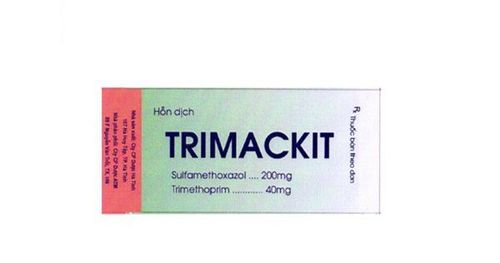This is an automatically translated article.
Carbotrim is made in the form of sugar coated tablets, the main ingredients are Sulfamethoxazole and Trimethoprim. This is an antibiotic that treats some infections.
1. What disease does Carbotrim treat?
What disease does Carbotrim treat? 1 Carbotrim tablet contains 200mg Sulfamethoxazole, 40mg Trimethoprim, 100mg activated charcoal and other excipients. Sulfamethoxazole has a bacteriostatic effect by inhibiting the formation of dihydrofolic acid by bacteria. Trimethoprim has a bactericidal effect by inhibiting the bacterial enzyme dihydrofolate reductase, inhibiting the formation of tetrahydrofolic acid from dihydrofolic acid (essential for bacterial DNA synthesis).
In Carbotrim tablets, 2 active ingredients Sulfamethoxazole and Trimethoprim are combined in a ratio of 5:1 to achieve a plasma concentration of 20:1 (optimal ratio for drug action). The 2-step inhibition of folic acid metabolism enables Carbotrim to have a synergistic antibacterial effect. This synergistic mechanism also contributes to combating the development of drug-resistant bacteria, making the drug effective against bacteria that are resistant to each component of the drug.
In addition, the activated charcoal ingredient helps absorb toxins that bacteria secrete on the digestive tract or ingredients that cause poisoning from food. Since then, the drug is effective in the treatment of gastrointestinal infections.
Indications for the use of Carbotrim:
Treatment of infections caused by susceptible strains of bacteria; Treatment of bacterial infections of the gastrointestinal tract (such as bacillus dysentery); Treatment of infections on the genital tract, urinary tract; Treatment of respiratory infections: Sinusitis, pneumonia, bronchitis, otitis media,...; Treat diarrhea caused by infection or food poisoning. Contraindications to using Carbotrim:
Patients with megaloblastic anemia caused by folic acid deficiency; Patients with severe renal failure, the concentration of the drug in the blood plasma cannot be monitored; People with severe liver disease may have toxic hepatitis; Infants, premature babies, children under 5 years old, pregnant women, the elderly; People who are sensitive or allergic to the active ingredients or excipients of the drug. Contraindications to Carbotrim here need to be understood as absolute contraindications, that is, not for any other reason that subjects with contraindications can be flexible in using the drug.
2. Usage and dosage of Carbotrim
Usage: Orally. Patients should take Carbotrim with meals with plenty of water (filtered, cooled boiled water).
Dosage:
Adults: Take a dose of 2 tablets/time x 3-4 times/day; Children 5 - 15 years old: Take 1-2 tablets/time x 2 times/day. It should be noted: The above drug dosage is for reference only, patients need to take the drug according to the instructions of the doctor who has prescribed and consulted. Do not arbitrarily change the dose, use more than the prescribed dose with the desire to speed up the treatment process.
Overdose: When using Carbotrim drug overdose, patients may experience symptoms such as headache, dizziness, nausea, vomiting,... Late manifestations of drug overdose are jaundice and confusion. hematopoietic disorder. When any symptoms of drug overdose appear, the patient should be hospitalized immediately for timely support and treatment. The treatment is to induce vomiting and gastric lavage. In the late stage with hematopoietic manifestations, patients should use Leucovorin 5-15mg/day until hematopoietic recovery.
Missed dose: If you forget to take a dose of Carbotrim, you should take it as soon as you remember. However, if it is almost time for the next dose, skip the missed dose and take the next dose at the scheduled time. There is no need to double the prescribed dose.
3. Side effects of the drug Carbotrim
When using Carbotrim, patients may experience some side effects such as:
Digestive: Glossitis, nausea, vomiting, diarrhea; Systemic: Fever, serum sickness, anaphylactic reaction; Skin: Skin pruritus, urticaria, angioedema, erythema multiforme, Lyell's syndrome, photosensitivity, Stevens - Johnson syndrome; Blood: Eosinophilia, purpura, neutropenia, megaloblastic anemia, agranulocytosis, hemolytic anemia, hyperkalemia, pancytopenia, hypoglycemia; Genitourinary - urinary: Kidney stones, kidney failure, interstitial nephritis. When experiencing side effects of Carbotrim, the patient should stop taking the drug and immediately notify the doctor or go to the hospital immediately for examination and timely treatment.
A few ways to reduce the side effects of Carbotrim:
Use more folic acid at a dose of 5 - 10mg/day to avoid the risk of folic acid deficiency; To reduce the risk of hyperkalemia, the concomitant use of Carbotrim with other hyperkalemic agents or with caution in patients with renal impairment may be considered; Should drink enough water when taking Carbotrim to avoid the drug crystallizing into stones; Do not expose to the sun to avoid the risk of a photosensitive reaction.
4. Caution when using Carbotrim
Some notes patients need to remember before and while taking Carbotrim:
Carbotrim can reduce kidney function; In elderly patients, long-term use of Carbotrim may cause folic acid deficiency; Carbotrim can cause dehydration, malnutrition; Carbotrim should be used with caution in people with chronic intestinal diseases; Carbotrim may cause hemolytic anemia in patients with G6PD deficiency; Patients should not drink alcohol while using Carbotrim; Patients must not arbitrarily stop taking Carbotrim without the permission of the doctor; Careful when using Carbotrim, closely monitor patients with HIV because this group of subjects is at risk of complications when taking the drug; Carbotrim can cause jaundice in children during the perinatal period (first 7 days after birth) by pushing bilirubin out of albumin. Therefore, Carbotrim should only be used during pregnancy when clearly needed. If this drug must be used, the patient should take folic acid; Because neonates are very sensitive to the toxicity of Carbotrim, nursing mothers should not take the drug.
5. Carbotrim drug interactions
Drug interactions can affect how well some drugs work or increase side effects. Therefore, the patient should inform the doctor about the drugs (prescription drugs, over-the-counter drugs, vitamins, ...) that they are taking. If you see any unusual signs, the patient should notify the doctor promptly.
Some drug interactions of Carbotrim include:
Concomitant use of Carbotrim with diuretics, especially thiazides, will increase the risk of thrombocytopenia in elderly patients; Concomitant use of Carbotrim with Methotrexate may reduce the elimination and increase the effect of Methotrexate; Concomitant use of Carbotrim with Pyrimethamine 25mg/week increases the risk of megaloblastic anemia; Concomitant use of Carbotrim with Phenytoin will inhibit the metabolism of Phenytoin in the liver, possibly leading to an excessive increase in the effect of Phenytoin; Co-administration of Carbotrim with Warfarin may prolong prothrombin time in patients receiving Warfarin. In summary, Carbotrim is made in the form of sugar coated tablets, with the main ingredients being Sulfamethoxazole and Trimethoprim. This is an antibiotic that treats some infections. When the doctor prescribes the use of Carbotrim, the patient should strictly follow the doctor's instructions, do not arbitrarily change the dose, use, time of taking the drug, ... At the same time, you should take the initiative to prevent avoid infection by eating cooked, drinking boiling water, washing hands clean, ... to protect yourself for your health.
Follow Vinmec International General Hospital website to get more health, nutrition and beauty information to protect the health of yourself and your loved ones in your family.













